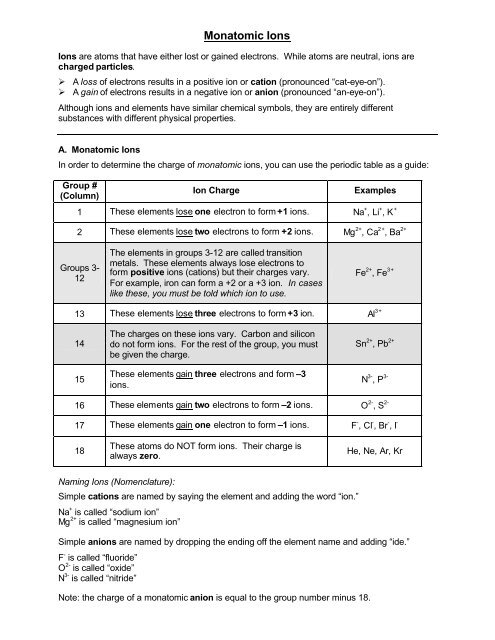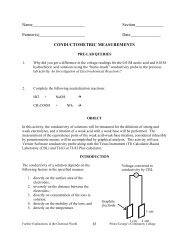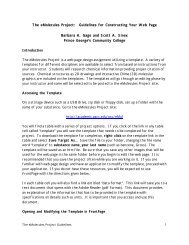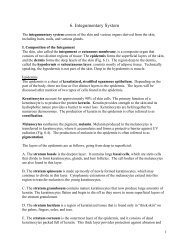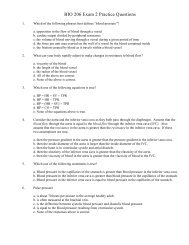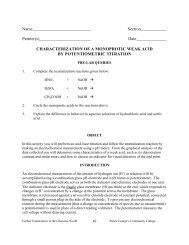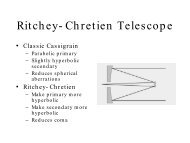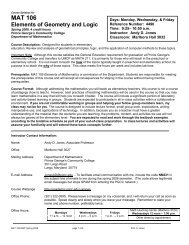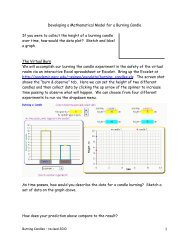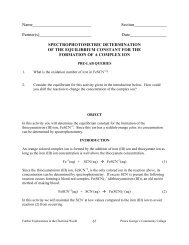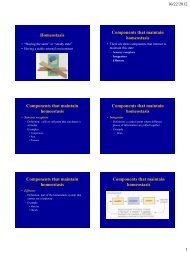Monatomic Ions
Monatomic Ions
Monatomic Ions
You also want an ePaper? Increase the reach of your titles
YUMPU automatically turns print PDFs into web optimized ePapers that Google loves.
<strong>Monatomic</strong> <strong>Ions</strong><strong>Ions</strong> are atoms that have either lost or gained electrons. While atoms are neutral, ions arecharged particles.‣ A loss of electrons results in a positive ion or cation (pronounced “cat-eye-on”).‣ A gain of electrons results in a negative ion or anion (pronounced “an-eye-on”).Although ions and elements have similar chemical symbols, they are entirely differentsubstances with different physical properties.A. <strong>Monatomic</strong> <strong>Ions</strong>In order to determine the charge of monatomic ions, you can use the periodic table as a guide:Group #(Column)Ion ChargeExamples1 These elements lose one electron to form +1 ions. Na + , Li + , K +2 These elements lose two electrons to form +2 ions. Mg 2+ , Ca 2+ , Ba 2+Groups 3-12The elements in groups 3-12 are called transitionmetals. These elements always lose electrons toform positive ions (cations) but their charges vary.For example, iron can form a +2 or a +3 ion. In caseslike these, you must be told which ion to use.Fe 2+ , Fe 3+13 These elements lose three electrons to form +3 ion. Al 3+1415The charges on these ions vary. Carbon and silicondo not form ions. For the rest of the group, you mustbe given the charge.These elements gain three electrons and form –3ions.Sn 2+ , Pb 2+N 3- , P 3-16 These elements gain two electrons to form –2 ions. O 2- , S 2-17 These elements gain one electron to form –1 ions. F - , Cl - , Br - , I -18These atoms do NOT form ions. Their charge isalways zero.He, Ne, Ar, KrNaming <strong>Ions</strong> (Nomenclature):Simple cations are named by saying the element and adding the word “ion.”Na + is called “sodium ion”Mg 2+ is called “magnesium ion”Simple anions are named by dropping the ending off the element name and adding “ide.”F - is called “fluoride”O 2- is called “oxide”N 3- is called “nitride”Note: the charge of a monatomic anion is equal to the group number minus 18.
Nomenclature Worksheet 1:<strong>Monatomic</strong> <strong>Ions</strong>Use a periodic table to complete the table below:Element Name Element Symbol Ion Name Ion Formula1. sodium2. bromine3. magnesium4. chlorine5. oxygen6. boron7. lithium8. neon9. phosphorus10. aluminum11. calcium12. iodine13. nitrogen14. cesium15. sulfur16. fluorine17. potassium18. barium19. hydrogen20. helium
Simple Binary Ionic CompoundsIonic compounds are compounds formed by the combination of a cation and a anion.(Think: “metal plus nonmetal”). Ionic compounds are more commonly known as“salts.” Binary ionic compounds are compounds containing only two elements, asdemonstrated in the examples below.When writing formulas for ionic compounds, we use subscripts to indicate how many ofeach atom is contained in the compound. Remember that even though ions havecharges, ionic compounds must be neutral. Therefore, the charges on the cation andthe anion must cancel each other out. In other words, the net charge of an ioniccompound equals zero.Example 1:For a salt containing sodium ion, Na + , and chloride, Cl - , the ratio is one to one. Thepositive charge on the sodium ion cancels out the negative charge on the chloride.(+1) + (-1) = 0Therefore, the formula for the salt is NaCl. (The actual formula is Na 1 Cl 1 , but chemistsomit subscripts of 1).Example 2:For a salt containing calcium ion, Ca 2+ , and chloride, Cl - , the ratio can’t be one to one.(+2) + (-1) = +1Remember that ionic compounds must be neutral. In order to yield a neutral compound,two chlorides must bond to the calcium ion:So, the formula for this salt is CaCl 2 .(+2) + 2(-1) = 0Nomenclature:When naming ionic compounds, simply write the element name of the metal followed bythe ion name of the nonmetal. (Remember: the metal ion (cation) is always writtenfirst!)NaCl is called “sodium chloride,” and CaCl 2 is called “calcium chloride.”
Please complete the following table:Nomenclature Worksheet 2:Simple Binary Ionic CompoundsName of Ionic CompoundFormula of Ionic Compound1. Sodium bromide2. Calcium chloride3. Magnesium sulfide4. Aluminum oxide5. Lithium phosphide6. Cesium nitride7. Potassium iodide8. Barium fluoride9. Rubidium nitride10. Barium oxide11. K 2 O12. MgI 213. AlCl 314. CaBr 215. Na 3 N16. LiF17. Ba 3 P 218. Cs 2 S19. SrF 220. NaCl
Polyatomic <strong>Ions</strong>Polyatomic ions contain two or more different atoms (polyatomic means “many atoms”).Here are some common examples:a. ammonium ion, NH 4 + (the only positive polyatomic ion you need to know)b. “ATE” ions: contain an atom bonded to several oxygen atoms:-Nitrate = NO 32-Carbonate = CO 33-Phosphate = PO 4-Acetate = CH 3 CO 22-Sulfate = SO 4-Chlorate = ClO 3c. “ITE” ions: remove one oxygen from the “ATE” ion and keep the same charge:-Nitrite = NO 2-Chlorite = ClO 2Phosphite = PO 33-Sulfite = SO 32-d. Other common complex ions:Hydroxide = OH - Cyanide = CN -Ionic Compounds Containing Polyatomic <strong>Ions</strong>As you’ve already learned, ionic compounds are formed by the combination of apositive ion (cation) and a negative ion (anion). This is the same when dealing simpleions or complex ions. Be careful to note, however, that complex ions are groupedtogether and should not be separated. In other words, don’t ever separate the sulfateion, SO 4 2- into sulfur and oxygen. If it’s written as a group, keep it as a group!Since complex ions come in groups, things can get tricky when using subscripts. As aresult, we use parentheses to separate the ion from the subscript:If we need two sulfates in a compound, we write: (SO 4 ) 2 .If we need three nitrates in a compound, we write: (NO 3 ) 3 .And, just as before, the net charge of the compound must be zero. For a saltcontaining sodium ion, Na + , and nitrate, NO 3 - , the ratio would be 1:1 since the positiveand negative charges cancel out. Therefore, the formula is NaNO 3 and is called sodiumnitrate. (Note: no parentheses are necessary here).For a salt containing calcium ion, Ca 2+ , and nitrate, NO 3 - , the ratio must be 1:2 (onecalcium ion for every two nitrates). So, the formula would be Ca(NO 3 ) 2 .
Nomenclature Worksheet 3:Ionic Compounds Containing Polyatomic <strong>Ions</strong>Please complete the following table:Name of Ionic CompoundFormula of Ionic Compound1. Sodium chromate2. Calcium carbonate3. Magnesium nitrate4. Aluminum sulfate5. Lithium phosphate6. Ammonium chloride7. Cesium chlorate8. Potassium sulfate9. Barium acetate10. Rubidium cyanide11. KCH 3 CO 212. Mg 3 (PO 4 ) 213. Al(ClO 3 ) 314. CaSO 415. Sr(HCO 3 ) 216. NaNO 317. Li 2 CO 318. Ba(NO 3 ) 219. Cs 2 CrO 420. NH 4 OH
Ionic Compounds Containing Transition MetalsThe transition metals are the elements located in the middle of the periodic table (in groups 3-12. Unlike the group 1A and 2A metal ions, the charges of transition metal ions are not easilydetermined by their location on the periodic table. Many of them have more than one charge(also known as an oxidation state). There are eight transition metals that you should highlighton your periodic table:Co, Cr, Cu, Fe, Mn, Hg, Sn, and PbEach of these elements form more than one ion and therefore must be labeled accordingly.For example, iron forms two ions: Fe 2+ and Fe 3+ . We call these ions “iron (II) ion” and “iron (III)ion” respectively. (See “Table of Transition Metal <strong>Ions</strong>”).When naming any ion from the elements listed above, you MUST include a Roman numeral inparentheses following the name of the ion. The this roman numeral is equal to the charge onthe ion. We don’t include the “+” because all metal ions are positive. Here are two moreexamples:Pb 4+ = “lead (IV) ion”Cr 3+ = “chromium (III) ionSimilarly, when naming a compound containing one of these transition metals, you mustinclude the Roman numeral as well. “Iron Chloride” isn’t specific enough since the compoundcould contain either iron (II) or iron (III) ion. You must specify the charge on the iron.Iron (II) chloride contains the Fe 2+ ion. When combined with chloride, Cl - , we know the formulamust be FeCl 2 .Iron (III) chloride contains the Fe 3+ ion. This time, three chlorides are required to form a neutralcompound. Therefore, the formula is FeCl 3 .By looking at the formula of an ionic compound, we can determine the charge (oxidationstate) of the metal.Example: Write the name of Co 2 O 31. Recognize that Co, cobalt, is a transition metal. This means that you must include a Romannumeral after its name. So, the basic name will be Cobalt (__) Oxide.2. To find the charge on cobalt, use oxide as a key. Oxide has a charge of –2 so three oxideswill have a charge of –6.3. What balances a –6 charge? A +6 charge! So, the positive half of the compound mustequal +6.4. Since there are two cobalt ions, the charge is split between them. So, each one has a +3charge. Therefore, we are using the Co 3+ ion and the compound is called cobalt (III) oxide.Remember that anions (negative ions) always have a definite charge. When dealing withcompounds containing transition metals, look to the anion first. Determine the charge of theanion and then solve to figure out the charge of the cation.When dealing with metals other than the transition metals, you don’t need Roman numerals. Inother words, calcium ion, Ca 2+ is always +2. Don’t call CaCl 2 “calcium (II) chloride.” Its name is“calcium chloride.”
Nomenclature Worksheet 4:Ionic Compounds Containing Transition MetalsPlease complete the following table:Name of Ionic CompoundFormula of Ionic Compound1. Copper (II) sulfate2. Copper (I) oxide3. Chromium (III) cyanide4. Cobalt (II) hydroxide5. Silver bromide6. Zinc nitrate7. Iron (III) acetate8. Lead (IV) sulfate9. FeCl 210. PbSO 311. Co 2 (CO 3 ) 312. AgNO 313. Zn(CN) 214. CuClO 315. Cr(OH) 316. Hg 2 O
Nomenclature Worksheet 5:Ionic Compounds SummaryName the following compounds:Give the formula for each compound:1. CaF 2 23. sodium fluoride2. Na 2 O 24. potassium sulfide3. BaS 25. calcium carbonate4. CuSO 4 26. magnesium hydroxide5. Fe 2 O 3 27. zinc nitrate6. HgCl 2 28. silver acetate7. AgNO 3 29. copper (II) oxide8. MgCO 3 30. iron (III) chloride9. KC 2 H 3 O 2 31. barium chromate10. K 2 Cr 2 O 7 32. aluminum oxide11. Al(OH) 3 33. lead (II) sulfate12. PbBr 2 34. tin (IV) oxalate13. ZnSO 3 35. calcium phosphate14. NaHCO 3 36. lithium permanganate15. NH 4 Cl 37. mercury (I) nitrate16. Li 3 PO 4 38. radium sulfite17. SnCl 2 39. chromium (III) chloride18. Al(NO 2 ) 3 40. ammonium sulfide19. Rb 2 CrO 4 41. copper (II) acetate20. KMnO 4 42. calcium bicarbonate21. CuCl 43. tin (II) oxide22. FeSO 4 44. silver sulfite
Naming Binary Covalent CompoundsBinary covalent compounds come from the combination of two nonmetals (or anonmetal and a metalloid). These compounds do not involve ions; as a result, theyhave a slightly different naming system. Chemists use prefixes to indicate the numberof atoms in each compound. The prefixes are listed in the table below:# of Atoms Prefix1 Mono2 Di3 Tri4 Tetra5 Penta6 Hexa7 Hepta8 Octa9 Nona10 DecaWhen naming binary covalent compounds, the first element name is given followed bythe second element with an “ide” ending. The first element gets a prefix when there ismore than one atom in the compound.* The second element ALWAYS gets a prefix.Here are some examples:CompoundNO*N 2 ONO 2*N 2 O 3N 2 O 4N 2 O 5NameNitrogen MonoxideDinitrogen MonoxideNitrogen DioxideDinitrogen TrioxideDinitrogen TetraoxideDinitrogen Pentaoxide* Notice that the prefix “mono” is omitted in these casesPrefixes are necessary when naming covalent compounds because the atoms cancombine in any whole number ratio. N 2 O, for example, cannot simply be called“nitrogen oxide,” because there are several other compounds that contain nitrogen andoxygen. We must specify that there are two nitrogen atoms bonded to a single oxygenatom.When dealing with ionic compounds, there is only one way for a cation and anion tocombine to form a neutral compound. As a result, there is no need to use prefixes.This is why CaCl 2 is called “calcium chloride,” rather than “calcium dichloride.”
Please complete the following table:Nomenclature Worksheet 6:Binary Covalent CompoundsName of Covalent CompoundFormula of Covalent Compound1. carbon dioxide2. phosphorus triiodide3. sulfur dichloride4. nitrogen trifluoride5. dioxygen difluoride6. N 2 F 47. SCl 48. ClF 39. SiO 210. P 4 O 10Determine whether the following compounds are covalent or ionic and give them theirproper names.1. Ba(NO 3 ) 22. CO3. PCl 34. KI5. CF 46. MgO7. Cu 2 S8. SO 29. NCl 310. XeF 6
Shortcut for Formula Determination:Use the following method when asked to determine the formula of an ionic compound:1. Write the two ions with their charges (metal first).2. Ignoring the + or – charges, “crisscross” the numbers and make them subscripts.3. Then, rewrite the formula, dropping the charges.(See Examples Below)Example 1:Write the formula for calcium chloride:1. Write the two ions with their charges (metal first).Ca 2+ Cl -2. Ignoring the + or – charges, “crisscross” the numbers and make them subscripts:Ca 2+ Cl -3. Then, rewrite the formula, dropping the charges. In this case, the formula is: CaCl 2.Example 2:Write the formula for magnesium oxide:1. Write the two ions with their charges (metal first).Mg 2+ O 2-2. Ignoring the + or – charges, “crisscross” the numbers and make them subscripts:Mg 2+ O 2-3. Then, rewrite the formula, dropping the charges. The rewritten formula is: Mg 2 O 2 .Note: Since the subscripts for the anion and cation are the same, the formula reduces toMg 1 O 1 .Therefore, the correct formula is written as: MgO.


